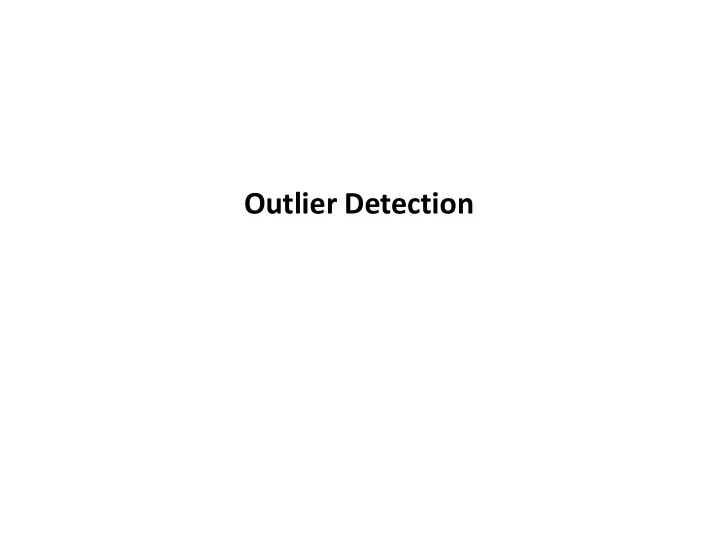

Outlier Detection
Outlier detection is both easy and difficult. • It is easy since there are several relatively straightforward tests for the presence of outliers. • It is difficult since there are no firm rules as to when outlier removal is appropriate. Outliers may be due to: • Chance. • Measurement error. • Experimental error.
Outliers may or may not be a problem, depending on many factors: • Some statistical tests are robust and can accommodate outliers, others may be severely influenced by outliers. ▪ Parametric test can unduly influenced. ▪ Non-parametric tests rarely are. • Some data types will naturally contain extreme values. ▪ Radiation levels often have extreme values (spikes). • The presence of outliers may, in fact, be of interest. ▪ Again, radiation spikes.
The outlier(s) may fall in a region of population overlap. This type of outlier must be removed from the data set.
Is this observation (57.00) an outlier?
In some cases a single outlier may influence normality, however, in this case the data are normal even with this observation. Tests of Normality Kolmogorov-Smirnov a Shapiro-Wilk Statistic df Sig. Statistic df Sig. Male Standing-Sitting Height .200 * .065 93 .986 93 .304 Ratio (Cormic Index) *. This is a lower bound of the true significance. a. Lilliefors Significance Correction Should this observation be examined further at this point?
Male Standing-Sitting Height Ratio (Cormic Index) Stem-and-Leaf Plot Frequency Stem & Leaf 1.00 Extremes (=<48.9) 3.00 49 . 446 12.00 50 . 012334557788 25.00 51 . 0122233344455566678888899 31.00 52 . 0111222233333334455555677789999 11.00 53 . 00111345789 7.00 54 . 0012378 2.00 55 . 02 1.00 Extremes (>=57.0) Stem width: 1.00 Each leaf: 1 case(s) The observation 57.0 is considered to be an extreme value in the stem and leaf plot.
When examining potential outliers, the detrended normal Q-Q plot is useful. • Observations are transformed to z-scores and plotted as standard deviations from the mean. This observation is nearly 1.5 standard deviations from the mean.
The best method of determining if an observation is an outlier is to use an outlier test. • The test gives the probability that an observation is from a different population. • It is defensible. • It DOES NOT tell you whether or not to remove the extreme observation(s)…
Grubbs Outlier Test x x x x max min G or G max min s s where G max is used if the observation is greater than the mean and G min is used if it is less than the mean, and where x max or x min is the extreme observation value.
Ho: The observation is not different than the sample population. Ha: The observation is different than the sample population. n 93 x 52 . 2 s 1 . 38 57 . 0 52 . 2 3 . 49 G max 1 . 38 From the G table at n=93 and α =0.05 the critical value is 3.18. Since 3.49 > 3.18, reject H o . The observation is from a different population (G 3.49 , p < 0.025).
Critical Values of Grubb’s Outlier (G) Test Taken from Grubb 1969, Table 1 N α=0.05 α=0.025 α=0.01 Calculated value falls about here.
Dixon Outlier (Q) Test x x n n 1 Q x x n 1 Where x n is the suspected outlier, x n-1 is the next ranked observation, and x 1 is the last ranked observation. Note that the data have to be ranked, with the suspected outlier as the first observation.
In SPSS Analyze > Descriptive Statistics > Explore, then choose the Statistics button and Outliers . Extreme Values Case Number Value 1 1 57.00 2 2 55.20 Highest 3 3 55.06 4 4 54.87 5 5 54.72 Male Standing-Sitting Height Ratio (Cormic Index) 1 93 48.93 2 92 49.46 Lowest 3 91 49.48 4 90 49.68 5 89 50.05 This gives the upper and lower extremes AND the next several observations, very useful when using the Dixon test.
Extreme Values Case Number Value 1 1 57.00 2 2 55.20 Highest 3 3 55.06 4 4 54.87 5 5 54.72 Male Standing-Sitting Height Ratio (Cormic Index) 1 93 48.93 2 92 49.46 Lowest 3 91 49.48 4 90 49.68 5 89 50.05 H o : The observation is not different than the sample population. H a : The observation is different than the sample population. n 93 57 . 00 55 . 20 1 . 8 Q 0 . 223 Q 0 . 1881 0 . 05 p 0 . 02 Critical 57 . 00 48 . 93 8 . 07 The observation is from a different population (Q 0.223 , 0.05 > p > 0.02).
Characteristics of the Dixon and Grubbs Tests Dixon Q: • Is the ratio of the ‘outlier gap’ to the data range. • Similar to the w/s (range) normality test. Grubbs G: • Is essentially a z score that references a modified t table. • Very similar to a one-sample t test.
The Grubbs test picks up extreme values earlier than the Dixon test, so choose the test that is most appropriate based on your knowledge of the data More normal Less normal Suspect Cormic value becomes increasingly extreme.
The same data used the generate the previous graph, displayed as a detrended Q-Q plot. 1 2 3 4 5 6
Final notes: Outlier tests are an iterative process. 1. Check most extreme value for being an outlier. 2. If it is, remove it. 3. Check for the next extreme value using the new, smaller sample. • It is smaller because the first outlier was removed. 4. Repeat the process. Once all outlier are removed the sample can be analyzed.
Recommend
More recommend